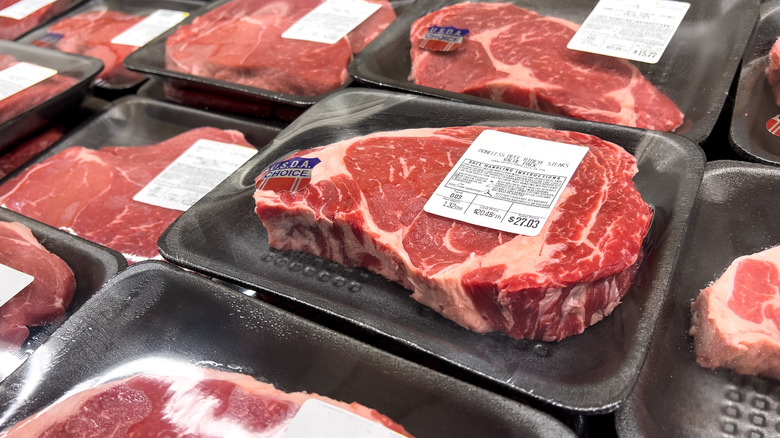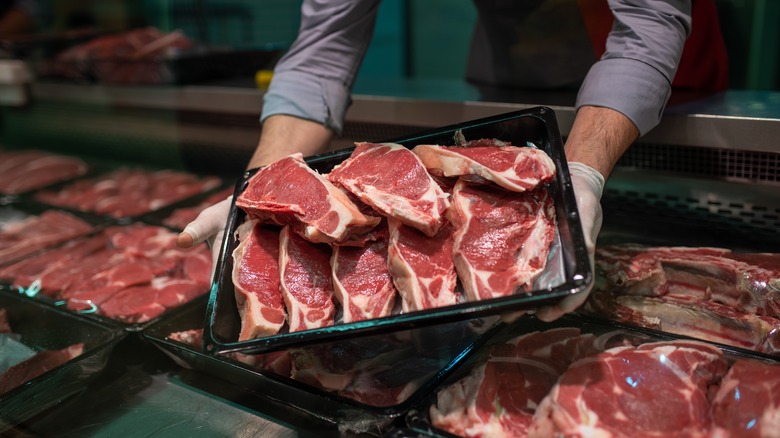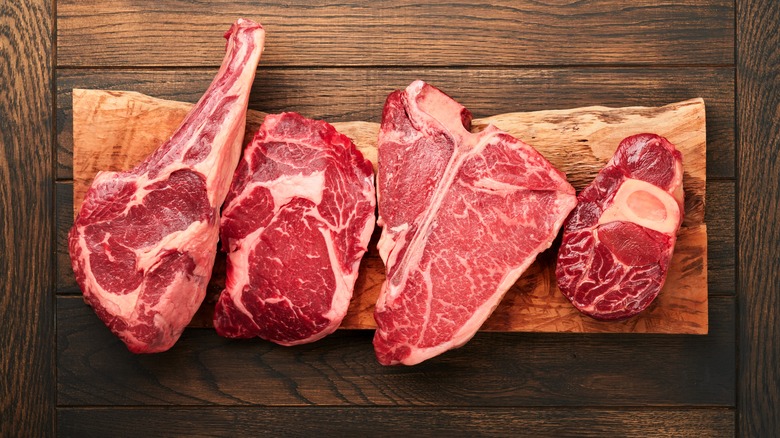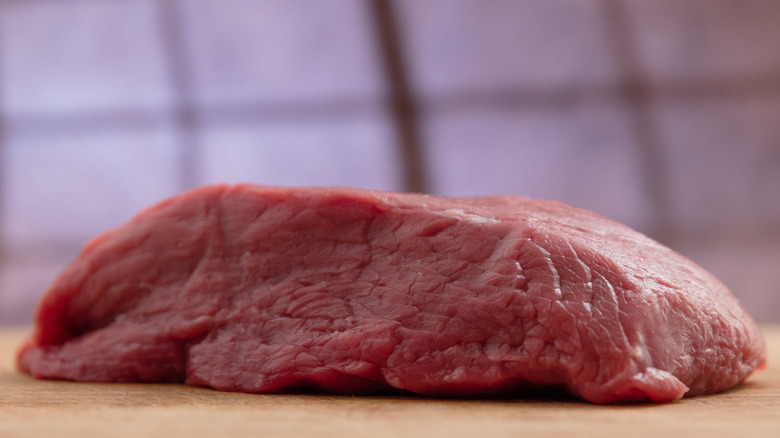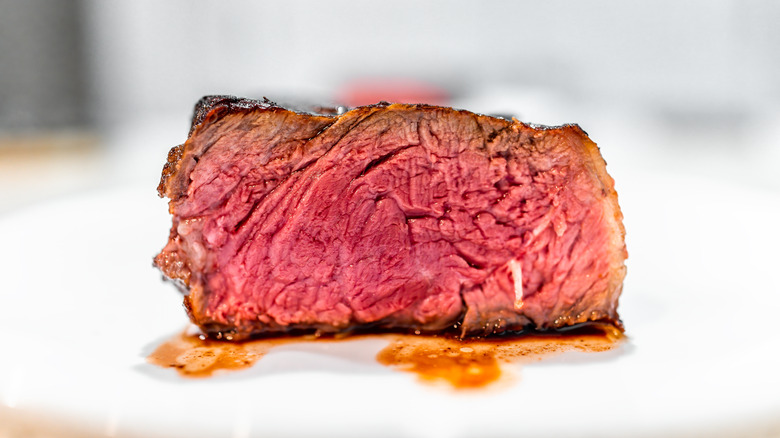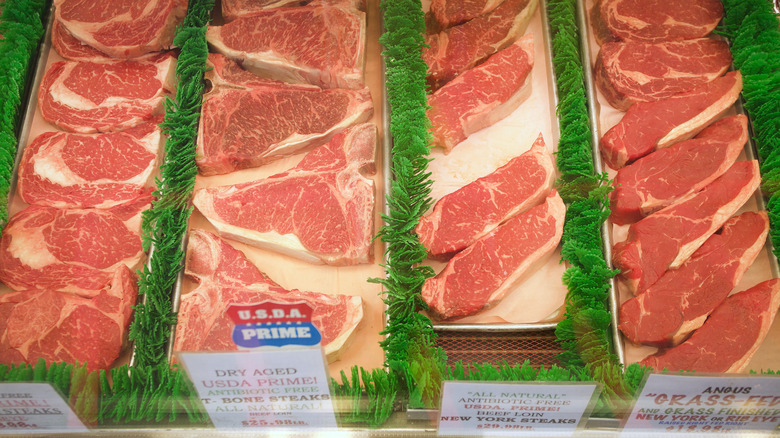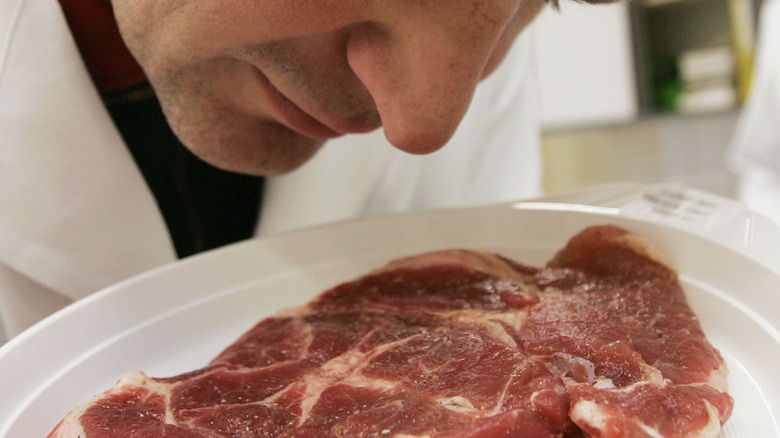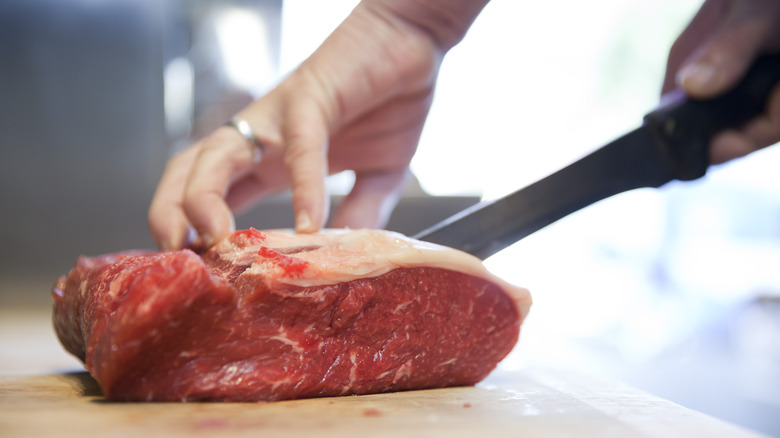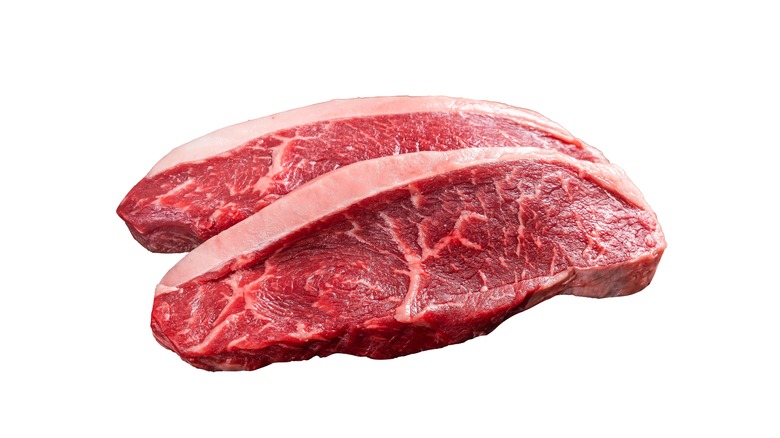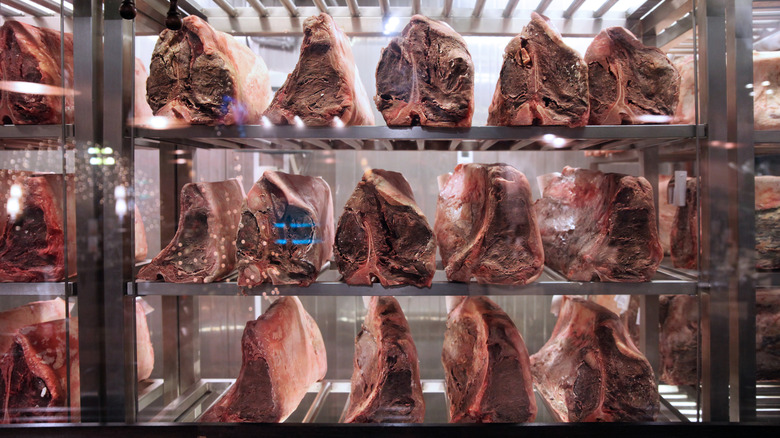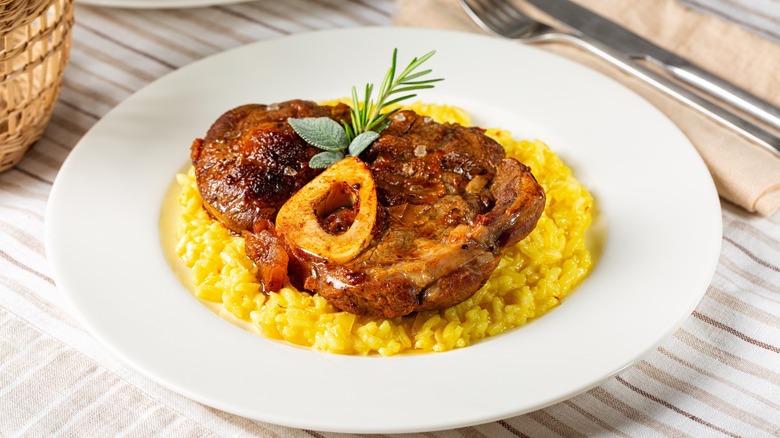A Culinary Director Shares How To Pick The Best Steak At The Grocery Store
Choosing a steak at the grocery store can be confusing for a discerning carnivore. The meat section has cuts available in a spectrum of colors, textures, and thicknesses — and with all those options, it's easy to get intimidated. But grilling meat at home is worth the extra effort, because steakhouses can be overrated – not to mention overpriced.
Grilling meat doesn't typically involve a whole lot of ingredients. Oil, salt, and pepper play supporting roles, but it's clear that the star of the show is the meat itself, so it's crucial that you choose a quality steak.
That's why I talked to chef Pete Geoghegan, culinary director for Cargill Protein, one of North America's largest beef processors, to find out just how to pick the best steak at the grocery store. With a few basic pointers, you'll be walking through the meat aisle with the swagger of a seasoned steak specialist — or, at the very least, having more confidence when it comes to shopping for the best steak.
Know your cuts
From flank steak to filet mignon, the meat section at the grocery store is full of different cuts, each one with unique flavors, applications, and grilling properties. If you're planning on grilling meat often, it helps to know the easiest (and most difficult) steaks to cook at home.
Skirt steak, for instance, is lean and usually has a lot of connective tissue, meaning it can be tougher, but it's super flavorful and lends itself to tenderizing marinades. So if you're making a flavorful steak dish like carne asada, skirt steak may be a great pick.
"Cuts in the middle of the animal, such as middle meats and around the sirloin area, don't have as much connective tissue, which means they are perfectly suited for grilling," says chef Pete Geoghegan, culinary director for Cargill Protein. Middle meats include popular cuts like strips, T-bones, and ribeyes, which are more tender and fatty and don't need as much care and attention as some of the leaner cuts.
Ask your butcher
As you probably know, there are a lot of factors to keep in mind when it comes to choosing the best steak at the grocery store — for instance, the type of meal you're preparing, how many people you're feeding, and budget can all come into play. While it's great to have this knowledge on hand, most people don't know everything there is about steak. Fortunately, there are people whose job is to know all the intricacies about meat — and they're usually behind the meat counter at many grocery stores to accommodate your questions.
Approaching the butcher can be intimidating, but if you're about to spend a pretty penny on a nice steak dinner, it's worth asking some questions. If you're eyeing a piece of ribeye, for example, ask your butcher about the best preparation method — or if you're cooking on a budget, inquire about what cut of meat is going to get you the most bang for your buck. Pete Geoghegan, chef and culinary director for Cargill Protein, advises, "In most grocery stores, you should be able to ask the butcher about the different cuts and let them know what you are looking for and they can steer you in the right direction."
Look for marbling
In the world of meat, marbling refers to the white streaks of fat that are found scattered throughout the muscular tissue (not to be confused with the large layer of fat along the edge of a T-bone, say, or the big strip of fat in a ribeye). To many meat lovers, including Pete Geoghegan, chef and culinary director, marbling is synonymous with a delicious steak. "If you like the leaner cuts, there is nothing wrong with that," he says, "but if you like the middle meats, I recommend looking for more of the marbling on your cuts for that more indulgent eating experience."
When a steak is heated, the marbling melts, coating the tougher muscle fibers around it and providing you with a more tender, juicy product. But not all marbling is created equal. Wagyu beef, for instance, is highly prized because of its fine marbling, meaning the streaks and flecks of fat are small and evenly distributed, resulting in a uniquely rich, buttery flavor. Coarser marbling, when the fat pockets are large and distributed unevenly, is not as desirable.
"Don't be afraid of the marbling," adds Geoghegan, "animal fat is not bad for you." While it's possible to have too much fat in your diet, animal fats provide essential nutrients that can be part of a healthy lifestyle.
Check color
When you're picking out a steak at the grocery store, the first thing to notice is the color of the meat. According to chef and steak expert Pete Geoghegan "color does indicate freshness and quality in most cases." He goes on to explain that, "If you are buying cut steaks, they should be a nice cherry red." Steak turns red when the chemicals in it interact with oxygen and since most grocery stores sell steak that's been pre-cut, they have a chance to turn a rich crimson color before you put them in your shopping cart.
But red isn't the only color you should be looking for. "When buying in bulk size like a whole striploin or tenderloin, the meat will be purple, which is completely fine," Geoghegan says. The same holds for meat that's been freshly cut and hasn't yet been exposed to oxygen. What you want to avoid is meat that looks dull and has a brown or yellow color, which can indicate the steak has gone bad.
Examine the thickness
If you're a well-done steak lover, it's time to do some soul searching. A steak is at its juiciest and most flavorful when there's still some pink in the middle — and in order to achieve that, you need a steak with a certain thickness. "I recommend going with at least 1 inch to 1 ½ inches for the thickness of your steak," says Pete Geoghegan, chef and culinary director for Cargill Protein. So before you plop that steak into your shopping cart, hold it up to get a good look at how thick it is.
It might not seem obvious, but a thicker steak is going to give you better flavor. If you're cooking steak medium or medium rare, you want the middle of the steak to remain pink, but still cook it enough to create "that beautiful crust/browning on the outside of the steak," Geoghegan adds. "If the steak is too thin, it will be overcooked by the time you get that beautiful sear on the outside."
Consider the grade
If you're a steak lover, you've probably heard of USDA grades like Prime, Choice, and Select, but do you know what they mean? It's something many Americans don't know about steak. "Of the three USDA grades," says Pete Geoghegan, chef and steak expert at Cargill Protein, "Select has the least amount of marbling (intramuscular fat), Choice has more than Select, and Prime has the highest amount." While different cuts of meat lend themselves to different preparations, higher intramuscular fat will typically lead to a richer, more tender flavor, which is why USDA Prime beef is often tastier and more expensive.
Since USDA grade meat is graded using a standardized system, when you buy meat with this label, part of what you're paying for is the certainty that a steak is going to meet certain standards. It's important to note that the USDA grading system is not required and it costs the meat processor extra money, which is passed down as an added cost to the consumer. There's plenty of great meat that's not graded by the USDA, but if you want a surefire way to buy a quality piece of meat, buying USDA grade meat is a safe bet.
Use your senses of smell and touch
Contrary to what you might think, that "sell by" date has nothing to do with food safety, so you've got to employ all your senses to get yourself the best meat at the grocery store. According to chef Pete Geoghegan, culinary director for Cargill Protein, "Our nose is probably the best judge of telling if meat is fresh." And while a lot of the pointers on this list require explaining so that you know what to look for, the smell of bad meat is pretty intuitive. As Geoghegan plainly puts it: "Spoiled meat does not smell good." Fresh meat, on the other hand has a mild, slightly metallic smell that won't be too noticeable. While most grocery stores do a good job of getting rid of spoiled meat, if you smell anything strange, it's a red flag.
Another way to tell if meat has gone bad is by evaluating its texture. Fresh meat should feel firm to the touch, springing back if you poke it with your finger. Avoid meat that looks slimy, sticky, or soft to the touch. Geoghegan goes by the classic kitchen rhyme "when in doubt, throw it out."
Buy whole muscle cuts
If you're a serious carnivore, you might want to consider buying bigger. According to chef Pete Geoghegan, "Buying larger whole muscle cuts and cutting your own steaks can save you money while still enjoying the more indulgent cuts." This tip isn't for everybody since it requires you to have some knife skills and be comfortable acting as your own butcher. But the payoff is worth it. Not only do you save money, but you also have more control over your steak and you can trim it to just the thickness of your liking.
A single loin can be trimmed and cut into 10 or more steaks, which can save you hundreds of dollars. And if you don't know where to start, consider watching a tutorial on Youtube like this one to learn how to make the most out of a massive hunk of meat. If you choose to go down this road, it helps to have a vacuum sealer and some free space in your freezer so that you can save some of your steaks for later.
Look for less popular cuts
Sure, some of us would like to have filet mignon for dinner every night, but not every delicious cut of meat is famous enough to be a household name — also, as you probably know, eating red meat too often isn't healthy. There are plenty of steaks out there that you may have avoided simply because you didn't know about them. "If you are looking to enjoy some steak that doesn't break the bank," says Pete Geoghegan, chef and culinary director for Cargill Protein, "I recommend looking for ranch steaks (cut from the shoulder, leaner but tender) or top sirloin."
While these cuts may not have the fine marbling of a pricey piece of ribeye, they're still great steaks. "Both cuts offer great lean beef flavor with less fat," Geoghegan adds, "but you can top them with some butter after it is cooked for an indulgent eating experience." If you've got a leaner piece of meat, you can also consider marinating it to soften it up, or you can even bathe your cut of meat in yogurt to make it more tender and juicy.
Look for dry-aged meat
If you've got some extra money and you want to impress a seasoned meat lover with a remarkable steak dinner, consider buying dry-aged steak. But why does dry-aged steak taste better and why is it more expensive?
Dry-aging steak is a process that involves allowing meat to sit in a controlled environment for several weeks — sometimes up to a few months. "While the moisture (water) evaporates, there are natural enzymes that break down the muscle fibers to make it more tender, along with bacteria (good bacteria) that helps with elevating the flavor," says chef and steak expert Pete Geoghegan. Dry-aged beef is known for its unique earthy, nutty, umami flavor profile that sets it apart from regular steak. The other popular aging method, wet-aging, uses similar logic and involves vacuum sealing meat and letting it rest to give the enzymes a chance to work their magic. It requires less equipment and can still produce a delicious steak, but it won't deliver the same level of culinary complexity as a dry-aged steak.
Consider your cooking method
This is also important to remember: Your meat is only going to be good if you know how to prepare it, and different meats require different preparation techniques. To understand how to pick the best meat for your cooking method, this is what chef Pete Geoghegan, culinary director for Cargill Protein, has to say: "It really helps to understand where the cuts of meat come from."
If you've got a lot of time on your hands and you want to stew or braise your meat, you have more latitude to use meat with more connective tissue because it'll break down during the cooking process. "Most of the cuts from the front of the animal (chuck), the rear of the animal (round), the belly (flank, navel), and chest (brisket), will have more connective tissue throughout the muscle fibers because of muscle use," Geoghegan adds. There are other cuts of steak you should always marinate before grilling, like flat iron, sirloin, and tri-tip. Naturally, tender cuts like filet mignon and ribeye don't require much more than some salt and a quick sear. So the best steak depends on how you're going to use it.
